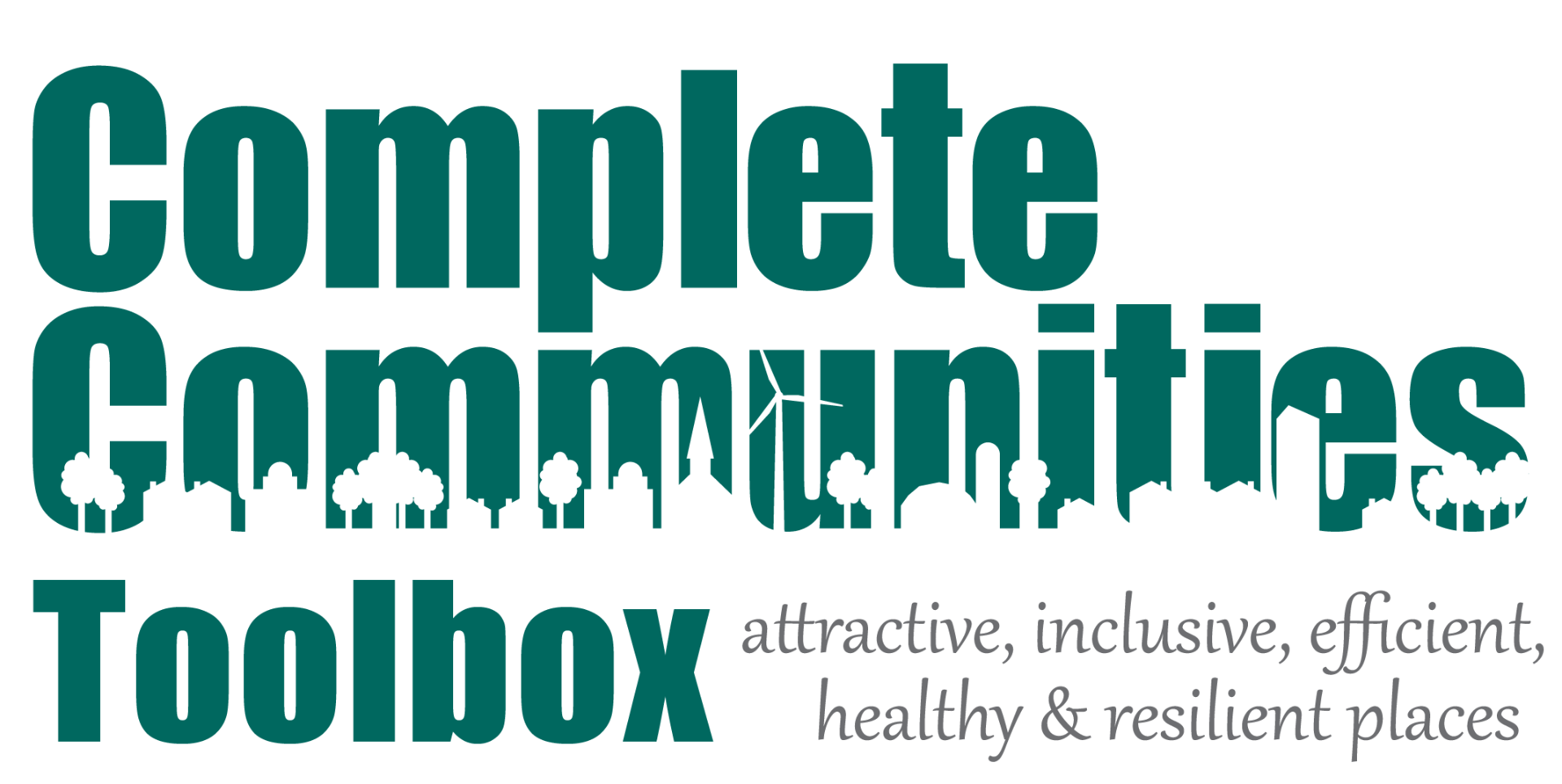With Adobe Express, the user can create a webpage to convey beautiful, shareable visual stories and social graphics. Adobe Express Pages use visual content to tell engaging web stories that communicate different aspects of planning for Complete Communities in Delaware.
Adobe Express Page Gallery
Complete Streets
Blueprint for a Bicycle-Friendly Delaware Framework for Local Implementation
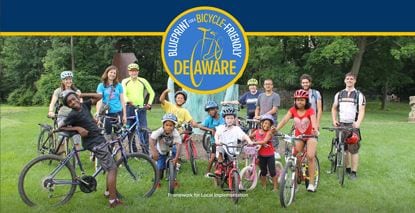 The Blueprint for a Bicycle-Friendly Delaware Framework for Local Implementation Adobe Express Page guides local governments through the process of developing a project and coordinating with regional and state entities in accordance with the Blueprint’s goals and DelDOT’s project prioritization process. Envisioning a Delaware where high-quality bicycle networks connect destinations and cyclists of all skill levels feel safe, DelDOT created the Blueprint for a Bicycle-Friendly Delaware to establish a transparent process through which DelDOT can support bicycle-friendly planning projects led by local governments. Through participatory planning and coordination with land use strategies, locally-driven bicycle planning builds a strong foundation for bikeability by more accurately identifying the wants and needs of each specific community.
The Blueprint for a Bicycle-Friendly Delaware Framework for Local Implementation Adobe Express Page guides local governments through the process of developing a project and coordinating with regional and state entities in accordance with the Blueprint’s goals and DelDOT’s project prioritization process. Envisioning a Delaware where high-quality bicycle networks connect destinations and cyclists of all skill levels feel safe, DelDOT created the Blueprint for a Bicycle-Friendly Delaware to establish a transparent process through which DelDOT can support bicycle-friendly planning projects led by local governments. Through participatory planning and coordination with land use strategies, locally-driven bicycle planning builds a strong foundation for bikeability by more accurately identifying the wants and needs of each specific community.
Low-Stress Cycling
 This Adobe Express Page showcases IPA’s Planning for Complete Communities in Delaware: The Low-Stress Bikeability Assessment Tool in visual format. The webpage flows logistically describing the concept of “Low Stress Cycling.” It features images of various cyclists and features common cycling problems such as road obstructions.
This Adobe Express Page showcases IPA’s Planning for Complete Communities in Delaware: The Low-Stress Bikeability Assessment Tool in visual format. The webpage flows logistically describing the concept of “Low Stress Cycling.” It features images of various cyclists and features common cycling problems such as road obstructions.
May is Bike Month in Delaware
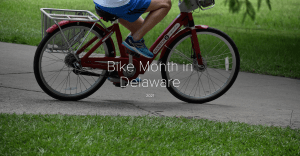 The Bike Month in Delaware Adobe Express Page promotes the extensive bicycling events being sponsored throughout Delaware in May to showcase the many benefits of bicycling. Delaware is ranked the 6th most bike-friendly state in the nation thanks to state policies, dedicated funding to bicycle infrastructure and trails, safety campaigns, and strong advocacy.
The Bike Month in Delaware Adobe Express Page promotes the extensive bicycling events being sponsored throughout Delaware in May to showcase the many benefits of bicycling. Delaware is ranked the 6th most bike-friendly state in the nation thanks to state policies, dedicated funding to bicycle infrastructure and trails, safety campaigns, and strong advocacy.
Parklets
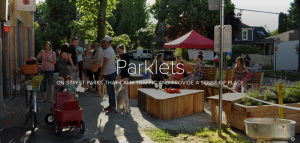 Parklets are extensions of the sidewalk from the curb into the street that are protected from traffic. They include installations of public seating, art, plants, platforms, and other elements that replace several on-street parking spaces, either permanently or temporarily. Several communities in Delaware are transforming on-street parking spaces into parklets. In this Adobe Express Page, discover how parklets in Delaware are becoming vibrant gathering places that are attracting people, reenergizing commercial districts, and calming traffic.
Parklets are extensions of the sidewalk from the curb into the street that are protected from traffic. They include installations of public seating, art, plants, platforms, and other elements that replace several on-street parking spaces, either permanently or temporarily. Several communities in Delaware are transforming on-street parking spaces into parklets. In this Adobe Express Page, discover how parklets in Delaware are becoming vibrant gathering places that are attracting people, reenergizing commercial districts, and calming traffic.
Pop-Up Demonstration and Pilot Projects
 Reconfiguring roadways and public spaces can help calm traffic and achieve more walkable-, bikeable-, and activity-oriented places. But permanent, large-scale changes can be difficult to launch. That’s why pop-up demonstration and pilot projects—that may test and evaluate temporary bike lanes, parklets, streetscaping, outdoor seating, redesigned parking, and more—are such valuable tools. View this Adobe Express Page to learn more about how pop-up demonstration and pilot projects collaboratively engage community members to temporarily transform and co-create high-value public spaces—including streets.
Reconfiguring roadways and public spaces can help calm traffic and achieve more walkable-, bikeable-, and activity-oriented places. But permanent, large-scale changes can be difficult to launch. That’s why pop-up demonstration and pilot projects—that may test and evaluate temporary bike lanes, parklets, streetscaping, outdoor seating, redesigned parking, and more—are such valuable tools. View this Adobe Express Page to learn more about how pop-up demonstration and pilot projects collaboratively engage community members to temporarily transform and co-create high-value public spaces—including streets.
Road Diet
 A “Road Diet” is roadway reconfiguration that involves narrowing or eliminating travel lanes to calm traffic and increase safety of all roadway users. A classic road diet converts a four-lane undivided roadway to a three-lane roadway with a center two-way turn lane. Road diets can also remove vehicle lanes from a roadway and reallocate the extra space for other uses or traveling modes, such as parking, sidewalks, bicycle lanes, transit use, turn lanes, curb extensions, parklets, or pedestrian refuge islands. Implementing Road Diets improves mobility and accessibility for all users, including pedestrians, bicyclists, and public transit riders. This Adobe Express Page explains benefits of road diets, provides examples traffic-calming elements, and provides Delaware-specific examples.
A “Road Diet” is roadway reconfiguration that involves narrowing or eliminating travel lanes to calm traffic and increase safety of all roadway users. A classic road diet converts a four-lane undivided roadway to a three-lane roadway with a center two-way turn lane. Road diets can also remove vehicle lanes from a roadway and reallocate the extra space for other uses or traveling modes, such as parking, sidewalks, bicycle lanes, transit use, turn lanes, curb extensions, parklets, or pedestrian refuge islands. Implementing Road Diets improves mobility and accessibility for all users, including pedestrians, bicyclists, and public transit riders. This Adobe Express Page explains benefits of road diets, provides examples traffic-calming elements, and provides Delaware-specific examples.
Efficient Land Use
Form-Based Codes
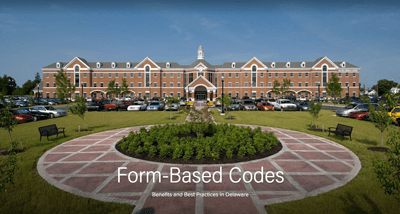 Conventional zoning codes can be notoriously tedious and difficult to understand. Alternatively, Form-Based Codes (FBCs) allow you to use pictures and diagrams to easily describe the types of development, redevelopment, parking, buildings, streets, open space, and so on that are acceptable in your community. FBCs use simple, everyday language and can cut up to sixty percent out of the length of the code. This Adobe Express Page provides an overview of the benefits of Form-Based Codes and how they are being implemented throughout Delaware.
Conventional zoning codes can be notoriously tedious and difficult to understand. Alternatively, Form-Based Codes (FBCs) allow you to use pictures and diagrams to easily describe the types of development, redevelopment, parking, buildings, streets, open space, and so on that are acceptable in your community. FBCs use simple, everyday language and can cut up to sixty percent out of the length of the code. This Adobe Express Page provides an overview of the benefits of Form-Based Codes and how they are being implemented throughout Delaware.
Healthy and Livable
Access to Healthy Food in Delaware
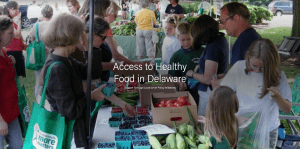 Access to healthy food plays a key role in creating complete communities where everyone has the chance to be happy and healthy. From making it more difficult for children to study in school to making people sacrifice other important purchases like medications, food insecurity impacts all aspects of people’s lives. Both food insecurity and unhealthy diets increase the risk of many chronic health conditions and stress. Sprawling land use patterns and strict separation of uses have contributed to creating built environments that make it difficult for people to access healthy food. This Adobe Express Page highlights how Delaware local governments can improve access to healthy food through comprehensive plans and community design, policies and regulatory tools, and local partnerships.
Access to healthy food plays a key role in creating complete communities where everyone has the chance to be happy and healthy. From making it more difficult for children to study in school to making people sacrifice other important purchases like medications, food insecurity impacts all aspects of people’s lives. Both food insecurity and unhealthy diets increase the risk of many chronic health conditions and stress. Sprawling land use patterns and strict separation of uses have contributed to creating built environments that make it difficult for people to access healthy food. This Adobe Express Page highlights how Delaware local governments can improve access to healthy food through comprehensive plans and community design, policies and regulatory tools, and local partnerships.
Active Living
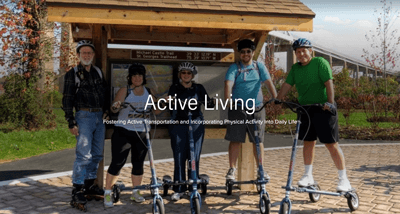 Designing communities that support active living and promote daily physical activity is a powerful way to create healthier communities. This Adobe Express Page conveys how local governments, along with interdisciplinary community partners, can influence the extent to which residents are physically active through careful crafting of land use plans, public policies, and changes to the built environment. Focus areas for active living include active transportation modes such as walking and biking, community design, school-based physical activity, and parks and recreation programs.
Designing communities that support active living and promote daily physical activity is a powerful way to create healthier communities. This Adobe Express Page conveys how local governments, along with interdisciplinary community partners, can influence the extent to which residents are physically active through careful crafting of land use plans, public policies, and changes to the built environment. Focus areas for active living include active transportation modes such as walking and biking, community design, school-based physical activity, and parks and recreation programs.
Creating Smoke-Free Public Places in Delaware
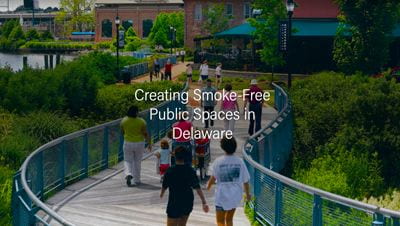 Smoke-free policies are public-sector regulations and rules that prohibit smoking in indoor spaces and designated public areas. The Toolbox section on Smoke-Free Delaware guides municipalities in developing policies that protect its residents’ health through the creation of more smoke-free public spaces. The Creating Smoke-Free Public Places in Delaware Adobe Express Page provides examples of policy strategies that may help Delaware municipalities as they strive to create smoke-free communities.
Smoke-free policies are public-sector regulations and rules that prohibit smoking in indoor spaces and designated public areas. The Toolbox section on Smoke-Free Delaware guides municipalities in developing policies that protect its residents’ health through the creation of more smoke-free public spaces. The Creating Smoke-Free Public Places in Delaware Adobe Express Page provides examples of policy strategies that may help Delaware municipalities as they strive to create smoke-free communities.
Jack A. Markell Trail
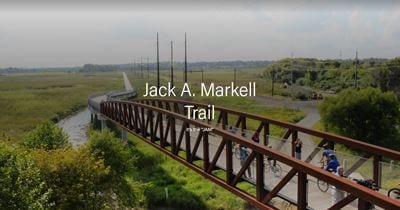 The Jack A. Markell Trail Adobe Express Page offers a visual guide to the new Jack A. Markell pedestrian and bicycle trail. The guide presents an overview of all the trail has to offer and a detailed synopsis of the trail’s construction and background. The Adobe Express Page also highlights the trail’s benefits to citizen health and to the community’s environment. The new trail is a monumental step toward a more healthy, active, and inclusive environment in Delaware.
The Jack A. Markell Trail Adobe Express Page offers a visual guide to the new Jack A. Markell pedestrian and bicycle trail. The guide presents an overview of all the trail has to offer and a detailed synopsis of the trail’s construction and background. The Adobe Express Page also highlights the trail’s benefits to citizen health and to the community’s environment. The new trail is a monumental step toward a more healthy, active, and inclusive environment in Delaware.
Inclusive and Active
Delaware Byways
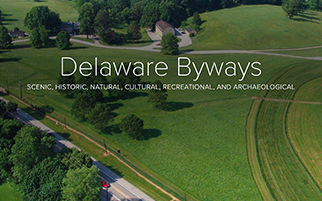 This Adobe Express Page showcases the Delaware Byways Program through stunning photography of each of the six designated Delaware byways: the Historic Lewes Byway; the Red Clay Valley Scenic Byway; the Delaware Bayshore Byway; the Harriet Tubman Underground Railroad Byway; the Nanticoke Heritage Byway; and the Brandywine Valley National Scenic Byway.
This Adobe Express Page showcases the Delaware Byways Program through stunning photography of each of the six designated Delaware byways: the Historic Lewes Byway; the Red Clay Valley Scenic Byway; the Delaware Bayshore Byway; the Harriet Tubman Underground Railroad Byway; the Nanticoke Heritage Byway; and the Brandywine Valley National Scenic Byway.
Placemaking
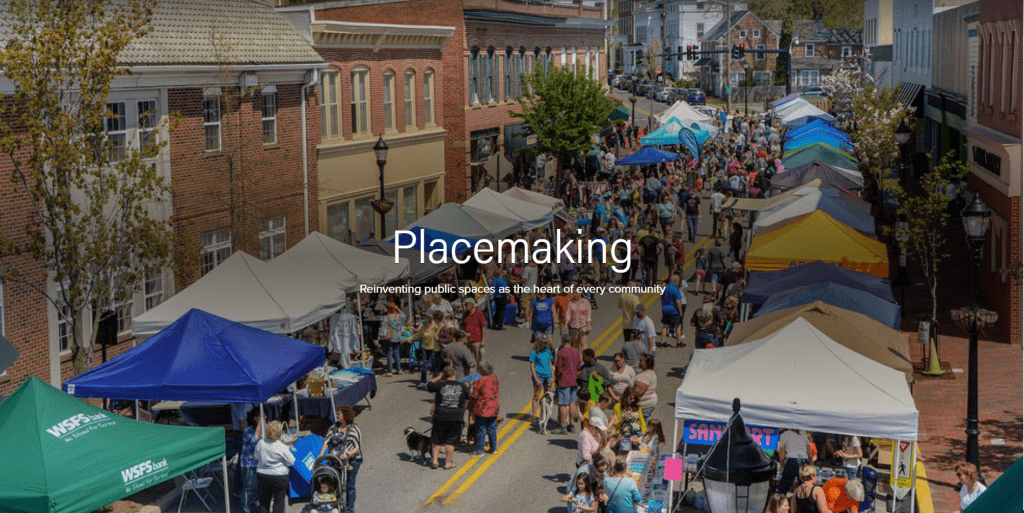 The Project for Public Spaces defines placemaking as “a multi-faceted approach to the planning, design, and management of public spaces.” Essentially, placemaking utilizes a local community’s assets, inspiration, and potential to design public spaces that contribute to people’s health, happiness, and well-being. This Adobe Express Page is centered around placemaking, which includes important resources to assist local governments in incorporating placemaking practices in their communities. The page features a brief description of “The Power of 10+” principle, key questions to consider when designing a public space, and a simplified infographic on “The Placemaking Process.”
The Project for Public Spaces defines placemaking as “a multi-faceted approach to the planning, design, and management of public spaces.” Essentially, placemaking utilizes a local community’s assets, inspiration, and potential to design public spaces that contribute to people’s health, happiness, and well-being. This Adobe Express Page is centered around placemaking, which includes important resources to assist local governments in incorporating placemaking practices in their communities. The page features a brief description of “The Power of 10+” principle, key questions to consider when designing a public space, and a simplified infographic on “The Placemaking Process.”
Sustainable and Resilient
Downtown Development Districts
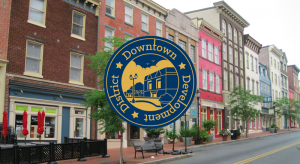 This Adobe Express Page highlights incentives offered by each of Delaware’s eight Downtown Development Districts (DDD) communities designated in 2015 and 2016. View statewide DDD and City of Dover interactive maps, a video on the City of Milford’s DDD, and project photos.
This Adobe Express Page highlights incentives offered by each of Delaware’s eight Downtown Development Districts (DDD) communities designated in 2015 and 2016. View statewide DDD and City of Dover interactive maps, a video on the City of Milford’s DDD, and project photos.

